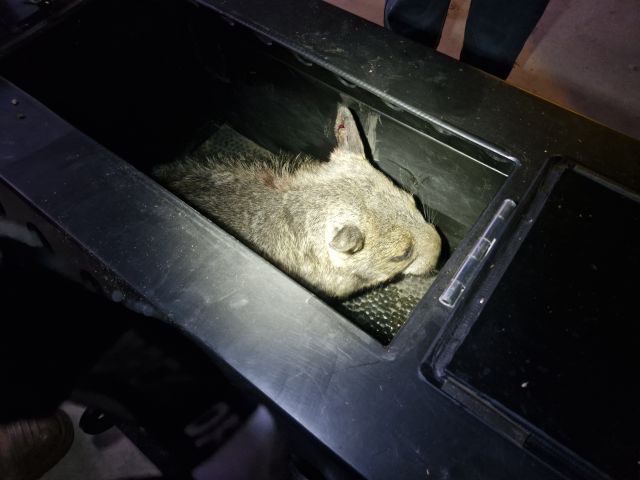 Open larger image
Open larger image
Eleven wombats were taken from Epping Forest National Park (Scientific) to Powrunna State Forest.
An additional 11 northern hairy-nosed wombats have been transported from Epping Forest National Park (Scientific) in Queensland's central west to Powrunna State Forest in the state's southwest.
This translocation project is an integral component of the Queensland Government's northern hairy-nosed wombat recovery program which aims to establish a third population of the endangered marsupial.
The project began in May 2024 after extensive preparation of the site at Powrunna and 37 wombats have already successfully been translocated.
In June 2025, rangers from across Queensland gathered at Epping Forest National Park (Scientific) to carefully trap six females and five males for relocation to their new home.
Principal Conservation Officer Samantha Ryan said there were now 21 females and 16 males at Powrunna, which had been specifically chosen for the third population of wombats.
"Monitoring by the Department of the Environment, Tourism, Science and Innovation shows the wombats have embraced their new home with plenty of new burrows," Ms Ryan said.
"We have already seen some young-at-foot on trail cameras, and our ultimate goal is to create another self-sustaining population of northern hairy-nosed wombats.
"Transportation takes around ten hours during the day when the wombats are usually sleeping, and they're released early in the evening into artificial burrows.
"Our goal is to translocate up to sixty wombats to Powrunna by 2026, and there is much hope that the population there will grow as it has at Epping."
Senior Program Officer David Field had never seen a northern hairy-nosed wombat prior to the translocation, and said it was wonderful to be involved.
"It was great to be involved in the planning, trapping, relocation and release of this endangered species and it's an experience I'll never forget," Mr Field said.
"I've learnt so much by working alongside experts, and the wombats were in excellent condition and were bigger and softer than you'd expect."
Rangers from the Queensland Parks and Wildlife Service have used radio trackers and remote cameras to monitor wombats at Powrunna, and site inspections show they have moved on from starter burrows and have dug multiple burrows of their own.
Northern hairy-nosed wombats previously ranged from New South Wales and into Queensland. In the eighties, the population of wombats at Epping Forest National Park was estimated to be around 35 and is now estimated to be at least 400.
Richard Underwood Nature Refuge near Wycombe is managed by the Australian Wildlife Conservancy and is home to a small population of northern hairy-nosed wombats.
The Gunggari Native Title Aboriginal Corporation (GNTAC) and Gunggari Native Title Holders, Glencore, The Wombat Foundation and Australian Wildlife Conservancy have provided ongoing support for this project.
In Queensland, some national parks are designated as "scientific" and are either fully or partially closed to the public to protect their natural values.






